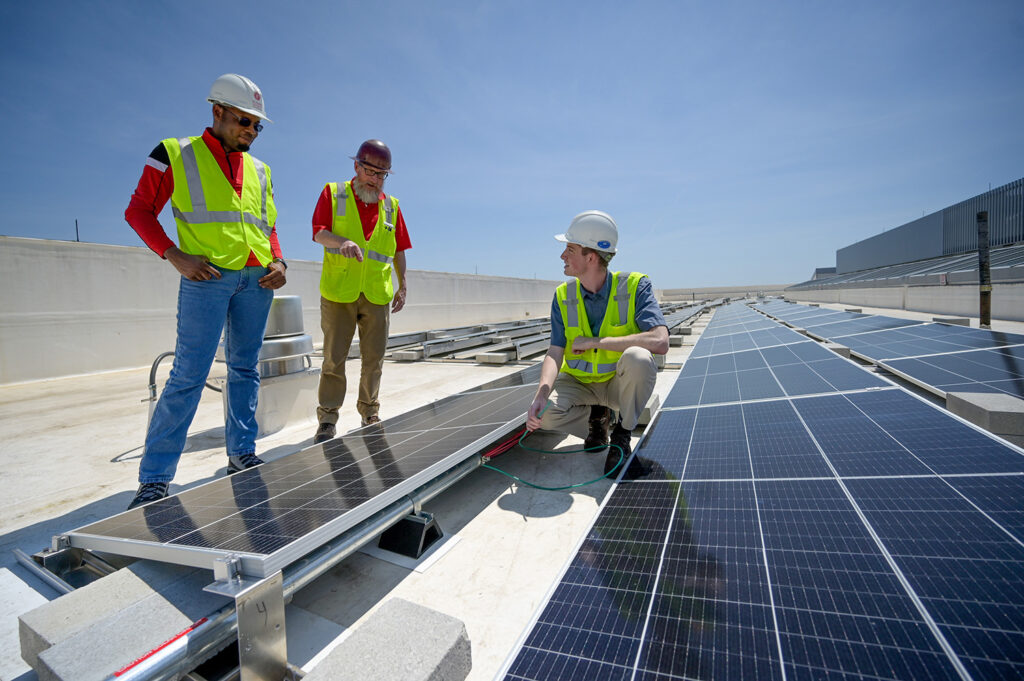As part of the current presidential administration’s Investing in America initiative, the U.S. Department of Energy (DOE) is giving $22 million to various institutions to improve efficiency in large-scale renewable energy and energy storage.
This includes $2 million to a team led by NC State’s North Carolina Clean Energy Technology Center (NCCETC).
“Large scale renewable energy deployment is a fairly new thing in the overall scheme of life, and a lot of communities have not experienced this yet,” said Steve Kalland, NCCETC executive director. “They’re learning themselves about what this means and they hear that it’s energy, so they think, ‘Oh, it’s like having a nuclear power plant in my backyard, or it’s like having a coal ash pond in my backyard.’”
The grant will allow creation of an online technical assistance and education hub. The hub’s purpose will be to address specific needs from communities, governments and developers in North and South Carolina.
North Carolina was one of the first states in the country and certainly the first in the Southeast to really see a utility-scale solar market emerge.
“Renewable energy is a lot more benign than those traditional energy resources,” Kalland said. “But there are definitely trade offs for a community to be aware of, and so this project is really about helping policymakers, landowners and community members understand better what the actual challenges and concerns are that they should have while at the same time helping them to kind of dispense with some of the mythologies that you can find on the internet.”
Every locality is different, which is why the center’s job is to explain exactly what is happening for each individual community. The first step of the project is learning what each group’s concerns and questions are about development, which involves the center sending out surveys and meeting communities in North and South Carolina, with an emphasis on disadvantaged communities. They will also be meeting with developers in the area.
Second, the Center will develop resources to address those concerns and build an online hub with resources, model ordinances, answers to questions and more.
The third and final phase involves educational workshops and delivering technical assistance for local governments throughout the Carolinas on siting and permitting issues. To do all of this, the Center will partner with North Carolina Cooperative Extension, which has field offices in every county in North Carolina, and with the South Carolina Energy Office, the Center for Energy Education and the Southeastern Wind Coalition.
“We’re doing our best to make sure we have good communications channels from trusted community partners, and that we are getting good, fact-based information into the hands of those communities through those mechanisms,” said Kalland.

“North Carolina was one of the first states in the country and certainly the first in the Southeast to really see a utility-scale solar market emerge. At one point, we were the second-largest solar market in the country behind California. We have a lot of this experience in this state. What has changed in recent years is the size and scale of these projects.”
Autumn Proudlove, managing director at the NC Clean Energy Technology Center, added that the DOE giving this grant to a North Carolina-based institution is indicative of continued faith in North Carolina’s dedication to renewable energy.
“It’s nice to be asked to help do something like this,” she said. “They could have gone pretty much anywhere in the country, and selecting the Carolinas as recipient of funding to support these issues, from our perspective, is a good thing.”
In the early 2000s, state policy limited solar projects so that they usually came in around five megawatts, which is about 50 to 70 acres. Those same projects today are anywhere from 20 to 100 megawatts, and Kalland says he once saw a project as large as 500 megawatts, or half a gigawatt.
“Duke Energy recently filed its carbon plan and it includes around 12 gigawatts of solar by 2035 and 17 and a half by 2038,” said Proudlove. “That’s a lot of solar that’s going to be added in the next 10 to 15 years, so these issues are going to continue and probably accelerate somewhat in communities because there’s so much new development planned.
“That’s why in our meetings in the first phase of the project, we’re prioritizing meeting in disadvantaged communities and actually going out to these communities and talking to these people to make sure that we get their perspectives.”



